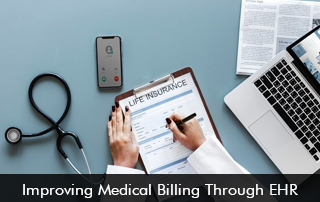The Electronic Health Record (EHR) has a significant impact on medical billing since it is leading the way in the modernization and simplification of the whole billing process. The efficacy, accuracy, and general efficiency of medical billing processes are greatly increased by this strong and comprehensive digital solution. Documentation, coding, integration with billing systems, eligibility verification in real-time, claim generation and submission, audit trail maintenance, patient billing, revenue cycle management, minimizing duplicate data entry, and effective denial management are just a few of the many ways that EHR delivers significant benefits to healthcare administration.
By combining these features, EHR not only makes it easier for clinical data to move smoothly into the billing domain, but also promotes a vast and interconnected healthcare ecosystem that assures the provision of high-quality patient care while streamlining financial paperwork. The healthcare business is entering a new age where the collaboration of clinical and administrative procedures is used to drive the sector toward increased operational effectiveness and better patient outcomes. This technological advancement signifies a paradigm change in the field.
Integration of billing system:
- One of the main features of Electronic Health Records (EHRs) is integration with billing systems, which facilitates an efficient and coherent flow of data from clinical documentation to the billing platform.
- This seamless integration is an example of technology working together to improve healthcare administration’s overall efficiency while also accelerating the transfer of critical data.
- In real terms, this connection removes the need for repetitious, error-prone human data entry that takes time. Healthcare practitioners can lessen the possibility of errors brought on by human input by automating the information flow between EHRs and billing systems.
Accuracy of Data and Work Saving:
Time is saved, and data accuracy is encouraged, guaranteeing that the rendered services exactly match the recorded patient care. Clinical and financial components function in tandem in a more coordinated healthcare environment thanks to the smooth integration.
Better Revenue Cycle management:
Healthcare practitioners may make well-informed judgments, improve revenue cycle management, and give patients correct billing information thanks to the constant and updated flow of information made possible by the real-time data interchange.
Digital Transformation:
The merging of EHRs and billing systems is a strategic development that cuts over conventional boundaries as the healthcare industry continues to embrace digital transformation.
It represents a comprehensive method of managing healthcare systems in which the quality of patient treatment is improved overall, administrative work is expedited, and any bottlenecks are reduced.
Improve financial process:
Better financial performance and higher standards of healthcare delivery are finally achieved by enabling healthcare providers to handle the complexity of billing procedures with more efficiency thanks to this technology integration.
EHR and patient billing:
The integration of patient billing functionalities into Electronic Health Records (EHRs) brings about a revolutionary improvement in the field of patient billing and engagement.
Specialized Portals:
Through specialized patient portals, this connection not only makes it easier for healthcare practitioners to create and transmit invoices quickly and effectively from the system, but it also gives patients access to clear and understandable billing information.
Patient centricity and experience:
- The integration of patient billing functionalities into electronic health records (EHRs) represents a paradigm change toward a patient-centered approach to healthcare management. Providers can expedite the billing process by utilizing the extensive features of EHR systems, guaranteeing precise invoicing and prompt patient financial information supply.
- By simplifying the intricacies associated with billing, this not only improves the overall patient experience but also the operational efficiency of healthcare institutions.
- The accessibility provided by patient portals coupled with EHRs benefits patients in turn. These portals function as customized platforms that allow users to easily access and examine their billing data.
- Patient portals encourage involvement and empowerment by offering an open view of incurred expenses, payment history, and pertinent financial information.
- Patients are better able to comprehend their financial obligations, ask questions about particular costs, and make well-informed choices about the costs of their medical treatment.
- Patient-provider contact is facilitated by the interactive features of patient portals.
- Clinicians are able to quickly respond to questions about billing, which promotes open communication and cooperation.
Leading and helping hand of Healthcare Professionals:
- This involvement improves patient satisfaction while also strengthening the impression of the healthcare provider’s dedication to openness and patient-centered treatment.
- Patient participation, transparency, and operational efficiency are given top priority in healthcare management, and this is exemplified by the integration of patient billing capabilities inside EHRs.
- The synergy between EHRs, patient billing, and interaction features illustrates a forward-looking approach that is in line with the wider objectives of enhancing healthcare delivery and the changing expectations of patients as the healthcare sector continues to change.







